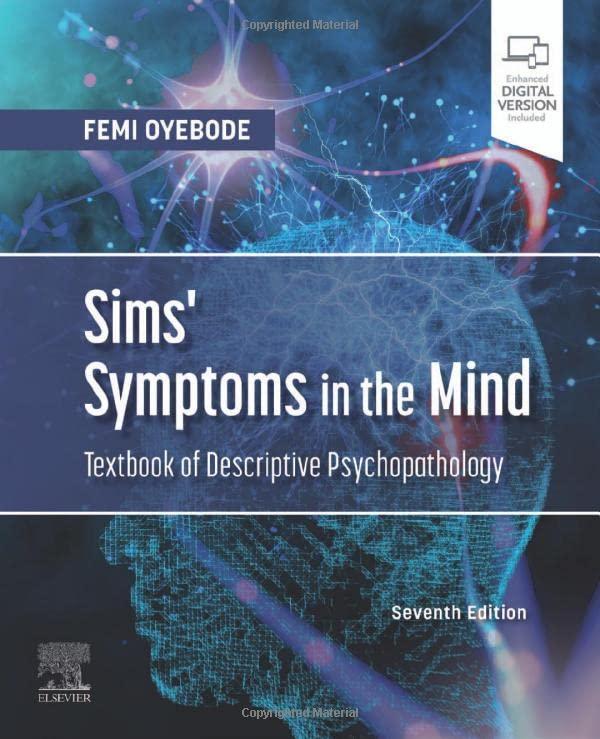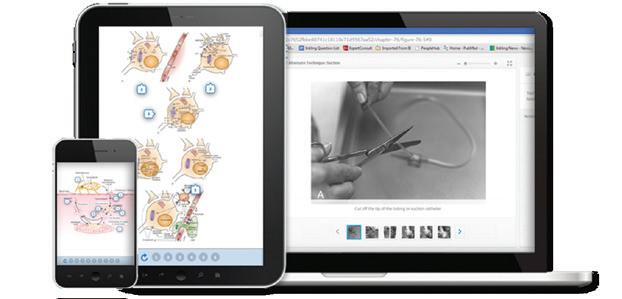Instant digital products (PDF, ePub, MOBI) ready for you
Download now and discover formats that fit your needs...
Sims. Síntomas mentales, 6a Ed 6th Edition Femi Oyebode
https://ebookmass.com/product/sims-sintomas-mentales-6a-ed-6thedition-femi-oyebode/
ebookmass.com
Sims' Symptoms in the Mind: Textbook of Descriptive Psychopathology 7th Edition Femi Oyebode
https://ebookmass.com/product/sims-symptoms-in-the-mind-textbook-ofdescriptive-psychopathology-7th-edition-femi-oyebode/
ebookmass.com
Mind and Heart of the Negotiator, The 6th Edition, (Ebook PDF)
https://ebookmass.com/product/mind-and-heart-of-the-negotiatorthe-6th-edition-ebook-pdf/
ebookmass.com
Business Ethics: Best Practices for Designing and Managing Ethical Organizations 2nd Edition, (Ebook PDF)
https://ebookmass.com/product/business-ethics-best-practices-fordesigning-and-managing-ethical-organizations-2nd-edition-ebook-pdf/
ebookmass.com
(eBook PDF) Criminal Justice: A Brief Introduction 13th Edition
https://ebookmass.com/product/ebook-pdf-criminal-justice-a-briefintroduction-13th-edition/
ebookmass.com
Plant Flow Measurement and Control Handbook 1st Edition Swapan Basu
https://ebookmass.com/product/plant-flow-measurement-and-controlhandbook-1st-edition-swapan-basu/
ebookmass.com
Pediatric Dermatology DDX Deck E Book 2nd Edition, (Ebook PDF)
https://ebookmass.com/product/pediatric-dermatology-ddx-deck-ebook-2nd-edition-ebook-pdf/
ebookmass.com
Requiem of Sin (Zakrevsky Bratva Book 1) Nicole Fox
https://ebookmass.com/product/requiem-of-sin-zakrevsky-bratvabook-1-nicole-fox/
ebookmass.com
Eletrônica Volume 1 8 ed. Edition Albert Paul Malvino
https://ebookmass.com/product/eletronica-volume-1-8-ed-edition-albertpaul-malvino/
ebookmass.com
Sims’ Symptoms in the Mind
Textbook of Descriptive Psychopathology
Femi Oyebode MBBS, MD, PhD, FRCPsych Professor of Psychiatry & Consultant Psychiatrist
University of Birmingham, National Centre for Mental Health Birmingham, UK
For my father, Jonathan Akinyemi Oyebode (1918–1971)
Femi Oyebode
CONCEPTS AND METHOD
What Is Psychopathology?
Psychopathology is the systematic study of abnormal experience, cognition and behaviour – the study of the products of a disordered mind. It includes the explanatory psychopathologies, in which there are assumed explanations according to theoretical constructs (for example on a cognitive, behavioural, psychodynamic or existential basis and so on), and descriptive psychopathology, which is the precise description, categorization and definition of abnormal experiences as recounted by the patient and observed in his behaviour (Fig. 1.1).
Descriptive psychopathology as distinct from other forms of psychopathology eschews explanation of the phenomena that it describes. It simply describes, thereby avoiding arguments about causation. Hence, descriptive psychopathology guards against and avoids theory, presupposition or prejudice. This constraint of descriptive psychopathology acts to secure the conceptual framework of phenomenology, restricting it to the actual experience of the patient. It is important to distinguish psychopathology from nosography, which is the description of single illnesses with provisional and characteristic features that lay the foundation for diagnosis (Stanghellini and Fuchs, 2013). Neither is it merely symptomatology nor pathology of the psyche (Stanghellini and Aragona, 2016; Stanghellini and Fuchs, 2013). It is, as elaborated later, a highly formalized and methodical system designed to inquire into and describe abnormal mental phenomena.
Explanatory psychopathologies, in contrast, often assume that mental phenomena are meaningful. In psychoanalysis, for example, at least one of several basic
mechanisms are assumed to be taking place, and the mental state becomes understandable within this framework. Explanations of what occurs in thought or behaviour are based on these underlying theoretical processes, such as transference or ego defence mechanisms. For example, with a delusion descriptive psychopathology tries to describe what it is that the person believes, how he describes his experience of believing, what evidence he gives for its veracity and what is the significance of this belief or notion to his life situation. An attempt is made to assess whether this belief has the exact characteristics of a delusion and, if so, of what type of delusion. Having made this phenomenological evaluation, the information gained can be used diagnostically, prognostically and hence therapeutically. Some of the contrasts between descriptive and psychoanalytic psychopathology are summarized in Table 1.1
Analytical or dynamic psychopathology, however, would be more likely to attempt to explain the delusion in terms of early conflicts repressed into the unconscious and now able to gain expression only in psychotic form, perhaps on a basis of projection. The content of the delusion would be considered an important key to the nature of the underlying conflict, which has its roots in early development. Descriptive psychopathology makes no attempt to say why a delusion is present; it solely observes, describes and classifies. Dynamic psychopathology aims to describe how the delusion arose, its psychological origins and, why it should be that particular delusion, on the evidence of that person’s experience in early life.
There are other radically different models of psychology that regard mental experience, including thoughts,
TABLE 1.1 Psychopathology: Descriptive Versus Psychoanalytic
Descriptive
Summary
Terminology
Methods
Differences in practical application
Empathic evaluation of patient’s subjective experience
Description of phenomena
Understanding the patient’s subjective state through empathic interview
Makes distinction between understanding and explanation: understanding through observation and empathy
Form and content clearly separated: form of importance for diagnosis
Process and development distinguished: process interferes with development basis
moods and drives, as epiphenomena, that is, as no more than froth on top of the beer. In these models (radical materialism or eliminative materialism), mental life is illusory; it is only the material, organic processes that are real. The significance the thinker attaches to subjective experience is regarded as purely illusory. Such a position poses difficulties for psychological enquiry and treatment and in any case is outside of the scope of this book.
Berrios (1996) has described two formulations of descriptive psychopathology in the nineteenth century. Psychologists and brain scientists predominantly tended to regard morbid phenomena as quantitative variations on normal mental functions – the continuity view.
Psychiatrists, working directly with the mentally ill (alienists), considered that some symptoms were too bizarre to have a counterpart in normal behaviour – the discontinuity view. Both formulations have contributed to the current state of descriptive psychopathology. Undoubtedly, the quality of empathy shown by the doctor contributes to the extent of understanding of the patient that is achieved. However, there is a theoretical limit to the psychological understanding that an interviewer can reach for some abnormal phenomena. It is often true that certain psychotic phenomena are such that the patient’s notions and behaviour may no longer be psychologically comprehensible through the use of empathy. In these situations the patient and doctor may have difficulty establishing a mutuality of understanding that, usually, readily underpins reciprocity and shared understanding. One of the consequences
Psychoanalytic
Study of the roots of current behaviour and conscious experience through unconscious conflicts
Theoretical processes demonstrated
Free association, dreams, transference
Understanding in terms of notional theoretical processes
No distinction made; concerned with content
No distinction made; symptoms seen as having unconscious psychological basis
is that patients may find that their experiences are not fully comprehended by the clinician involved in their case. This fact underlines how alienating psychotic experiences can be. These two formulations, the continuity and discontinuity views, continue to influence how abnormal phenomena are conceptualized even today. There are two distinct parts to descriptive psychopathology – the empathic assessment of the patient’s subjective experience and the observation of the patient’s behaviour. Empathy is an important psychiatric term that literally means ‘feeling oneself into’ and in psychiatric practice emphasizes the imaginative experiencing of another person’s inner, subjective world. It can be distinguished from sympathy, which is ‘feeling with’. A way to appreciate the distinction between ‘empathy’ and ‘sympathy’ is to recognize the role of an objective stance towards the patient coupled with an active attempt to fully understand how certain thoughts rise from particular moods, wishes or fears and the nexus of connections between different aspects of the patient’s experiences that is integral to empathy.
In descriptive psychopathology, the concept of empathy is like a clinical instrument, conceptual in mode but no less incisive for that matter, that needs to be used with skill to explore, measure and represent to oneself another person’s internal subjective state. The observer’s own capacity for imaginatively representing another person’s emotional and cognitive experience to himself acts as the necessary instrument in this clinical task. Empathy is achieved by precise,

phenomenology in psychiatry is entirely subjugated to its single purpose of rendering the patient’s experience understandable (this is a technical word in phenomenology and is described in more detail in the Understanding and Un-understandable section; however, it incorporates the capacity for putting oneself in the patient’s place) so that classification and rational therapy may proceed. It is not the assimilation of abstruse facts or the accumulation of foreign eponyms that is most difficult in phenomenology, although either of these may be hard: it is the comprehension of a method of investigation, a rigorous approach and the ability to use new concepts. In an attempt to avoid the obscure and obvious, some of these concepts are discussed in the rest of this chapter.
Concepts DISEASE AND ILLNESS
Psychopathology concerns itself with disease of the mind, but what is disease? And, how does it differ from disorder and illness? This is a vast subject that has received discussion from philosophers, theologians, administrators and lawyers as well as from physicians. Doctors who spend most of their working time dealing with disease rarely ask this question and even less frequently attempt to answer it. Talk of disease by definition raises questions about the nature of health. But, an even more pressing issue is whether it is possible for the mind to be diseased in the same way or manner that the liver or the kidneys can be diseased. These questions are outside of the scope of this book, but it is important to be aware of the varied approaches that different authorities take to this matter. I outline the basic arguments in the following text.
The most compelling model of a disease is that which grounds a medical condition such as pulmonary tuberculosis on the basis of a distinctive morbid anatomy demonstrable on examination of the lungs and which is independent of any particular observer and is assumed to be value free. It is even better if there is an understanding of the detailed pathophysiology – how the causative agent, in tuberculosis for instance, results in the recognized, typical morbid anatomy of the lungs. It is obvious from the foregoing that in most psychiatric diseases, no such typical morbid anatomy or pathophysiology has been described.
On the basis of the absence of demonstrable physical lesions, Szasz (1960) argued that psychiatric or mental diseases did not exist and that only behavioural deviance and moral or social judgements were at play in psychiatry. He also argued that mental is an abstract concept and not an objective, physical thing, and hence it could not be diseased. Brain diseases, in his view, are real, but mental diseases are a logical impossibility; thus Szasz uses the term myth to characterize mental diseases.
Other writers including Scadding (1967), Kendell (1975), Boorse (1976) and Sedgwick (1973) have put forward arguments that stand in opposition to Szasz. Scadding and Kendell use the combination of statistical deviance and biological disadvantage defined as reduced fertility to determine what a disease is. Boorse adds that a disease is any condition that interferes with any function of an organism (and in this view mental functioning counts) that is necessary for its survival and reproduction. Additionally, a disease becomes an illness when it is deemed undesirable, a title for special treatment and a valid excuse for particular behaviours. Finally Sedgwick makes the claim that all diseases start off as illnesses because the symptoms are negatively valued and hence become a focus of social and moral interest, and that in this way the symptoms later attain disease status. In this account both the so-called physical illnesses and mental illnesses start off as negatively valued states afflicting human beings and there is no sharp distinction to be drawn between them. See Fulford, Thornton and Graham (2006) for further elaboration of these issues.
It is clear that there is no widely accepted view about the status of the conditions that fall under the interest of psychiatrists. A simple dictum is to regard disease as what doctors treat and illness as what persons suffer from. Although this distinction between normality and disease, health and illness, is by no means trivial:
A large part of medical ethics and much of the whole underpinning of current medical policy, private and public, are squarely based on the notion of disease and normality. Left to himself the physician (whether he realizes it or not) can do very well without a formal definition of disease … Unfortunately, the physician is not left alone to work his common sense. He is attacked from two angles: the predatory consumers and the pretentious advisers. Murphy (1979)
BOX 1.1 STATIC AND GENETIC UNDERSTANDING
Understanding is the perception of personal meaning of the patient’s subjective experience.
• If we want to find meaning at a particular moment in time, the method of phenomenology is appropriate. The patient’s subjective experience is dissected out, and a static picture is formed of what that thought or event meant to him at that particular time. No comment is made on how the event arose, and no prediction is made as to what will happen next. The meaning is simply extracted as a description of what the patient is experiencing and what this signifies to him now. A man feels angry: static understanding uses empathy to describe in detail exactly what it is like for him to feel angry. Have I, the examiner, experienced phenomena like these? Are they known to me through the experiences I have had in my lifetime?
• Genetic understanding, as opposed to static understanding, is concerned with a process. It is understood that when this man is insulted, he reacts with violence; when that woman hears voices commenting on her actions, she draws the curtains. For understanding the way that psychic events emerge one from another in the patient’s experience, the therapist uses empathy as a method or a tool. He feels himself into the patient’s situation. If that first event were to have occurred to him personally in the patient’s total circumstances, the second event, which was the patient’s reaction to it, might reasonably be expected to have followed. He understands the feelings he ascribed to the patient by the action that results from these feelings. So if I were the patient with the same history, do I feel that I would have the same experiences and behave in the same way? An example would help to demonstrate the humanity of this approach and the universality of human experience: I must put myself into the shoes of another young woman, aged 19, also raised in an isolated fishing community, the eldest of eight siblings, who becomes stuporose during her second pregnancy. She is married to an alcoholic man aged 35, and her father is also alcoholic. I must understand how she dealt with her father’s alcoholic behaviour as a child, what her pregnancy meant to her, how she regarded her mother’s behaviour during her own pregnancies and so on.
BOX 1.2 STATIC AND GENETIC EXPLANATION
• Static explanation is concerned with external sense perception, observing an event, for example ‘I witnessed the 1999 eclipse in Plymouth’.
• Genetic explanation consists of unravelling causal connections; it describes a chain of events and why they follow that sequence (‘visual perception of the eclipse is the result of physiologic changes in my retina, which in turn produce changes in my occipital cortex that ultimately cause me to see the eclipse’).
should be concerned with persecution by the Nazis – perhaps because her parents escaped from Germany in 1937. But we can have no understanding of why she should believe something that is demonstrably false (e.g., that her persecutors are putting a tasteless fluid into her drinking water that makes her feel ill). The delusion itself, as psychopathological form, is ununderstandable. Meaningful connections, then, show the linkage between different psychological events by understanding how these events emerge one from another by a process of empathy.
This is a controversial concept in that it implies that there are aspects of another person’s mental life that are beyond our grasp and empathic understanding. It contradicts another axiom in psychiatric practice, namely that our purpose is to understand another person, and when understanding fails, it calls into question how conscientious and rigorous the psychiatrist has been in the pursuit of grasping the inner life of the patient.
EMPATHY
The classic method in medicine of gaining information about the patient is from the history and by physical examination. The use of phenomenology in psychiatry is an extension of the history, in that it amplifies the description of the present complaint to give more detailed information. It is also examination in that it reveals the mental state. It is not possible for me, the doctor, to observe my patient’s hallucination or in any direct way to measure it. However, what I can do to comprehend him is to use those human characteristics I hold in common with him: the fact that we inhabit the same world of meanings, that we communicate in language and that like him I have a rich inner life. It is also important to be intellectually curious and genuinely interested in the inner life of another person. The


which the patient suffers. For example, delusional percepts occur in schizophrenia, and when demonstrated as the form of the experience they indicate this condition. The finding of a visual hallucination suggests the likelihood of an organic brain disease (Chapter 7). The nature of the content of these two examples is irrelevant in coming to a diagnosis. The content can be understood by the patient’s life situation with regard to culture, peer group, status, sophistication, age, sex, life events and geographic location. For example, another patient described himself as having been sent to the moon and back during the night within a fortnight of the first landing by man on the moon. Describing one’s thoughts as being controlled by television is necessarily confined to those people who have seen that invention.
Hypochondriacal content can occur in more than one form. It could take the form of an auditory hallucination in which the patient hears a voice saying ‘You have cancer’. It could be a delusion, in that he holds with conviction the false belief that he has cancer. It could be an overvalued idea, in that the patient has a conviction arising from prior experience of a mistaken diagnosis of cancer, and this results in him spending a major part of every day checking on his health. It could be an abnormality of affect that manifests itself in extreme hypochondriacal anxiety or in depressive hypochondriacal despondency.
The significance of culture and individual variation in ascertaining the detailed complaint of the patient should be stressed. Because the psychiatrist needs to assess whether this notion of the patient demonstrates the specific psychopathological form of delusion, it does not diminish the parallel need to understand the patient’s philosophic, religious, political and social beliefs and know how they fit, or fail to fit, into the patient’s larger, national and more intimate, subcultural social contexts (Fabrega, 2000).
Alongside the need of the psychiatrist to acquire skills in psychopathology and the elucidating of mental symptoms is the parallel requirement for cultural education and sensitivity. Both aspects are necessary for every patient–doctor interaction. If anything, the painstaking and detailed study of phenomenology increases the awareness of the cultural context and how it influences cognition and behaviour.
PRIMARY AND SECONDARY PHENOMENA
Jaspers discusses the different meaning that can be given to the terms primary and secondary when applied to symptoms. The distinction may be in terms of understanding; what is primary is immediate and ultimate and therefore cannot be further reduced by understanding, for example hallucinations. What is secondary is what emerges from the primary in a way that can be understood, for example delusional elaboration arising from the healthy part of the psyche in response to hallucinations from the unhealthy part of the psyche. Again, the conceptual distinction of what is primary or secondary may be determined by the causal chain, in that what is primary is the proximate cause, whereas what is secondary is the discernible distal effect. A cerebrovascular accident causes sensory aphasia and is therefore primary; the aphasia is the distal effect and is therefore secondary to the cerebrovascular accident.
These two distinct meanings of the term primary overlie the crucial distinction between meaningful connections and causal connections. For the avoidance of doubt in physics and chemistry, we make observations by experiment and then formulate causal connections and causal laws, whereas in psychopathology we experience another sort of connection, in which psychic events emerge out of one another in a way that can be understood – so-called meaningful connections.
SUBJECTIVITY AND OBJECTIVITY IN PSYCHOPATHOLOGY
Objectivity in science has come to be revered as the ideal, so that only what is external to the mind is considered to be real, measurable and valuable. This is a mistake, because objective assessments are necessarily subjectively value-laden in what the observer chooses to measure, and this subjective aspect can be made more precise and reliable. There are always value judgements associated with both subjective and objective assessments. The process of making a scientific evaluation consists of various stages: receiving a sensory stimulus, perceiving, observing (making the percepts meaningful), noting, coding and formulating hypotheses. This is a progressive process of discarding information, and it is the subjective judgement of what information is valuable that determines the small amount from each













